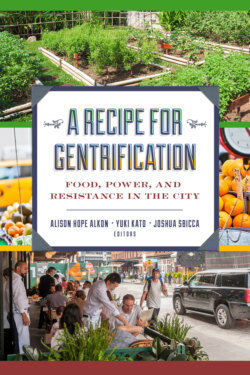Читать книгу A Recipe for Gentrification - Группа авторов - Страница 19
2 Savior Entrepreneurs and Demon Developers
ОглавлениеThe Role of Gourmet Restaurants and Bars in the Redevelopment of Durham
NINA MARTIN
In 2013, Southern Living Magazine chose an unlikely candidate as its “tastiest town” in the South: Durham, North Carolina. Known for its depiction in the film, Bull Durham (1988), where minor league baseball players fight for their future in the gritty tobacco town, Durham beat out New Orleans, Charleston, Atlanta, and other well-known “foodie” cities. The city’s culinary offerings have been widely celebrated in such publications as Vogue (2017), Bon Appétit (2016), and the New York Times (2013, 2017), which notes that Durham’s emergence as a food city paralleled the regeneration of its downtown area. Indeed, until 15 years ago Durham’s deindustrialized city center had many empty storefronts, abandoned tobacco warehouses, and depopulated streets. But visit Durham today and you can experience the following itinerary: Begin your day at an independent coffee shop by enjoying drinks made with single-origin beans, then walk over to the farmers’ market where you will find locally grown organic produce, snag lunch at a food truck that specializes in culturally hybrid street foods from around the world, shop at boutiques and art galleries with curated collections, have dinner at a farm-to-table restaurant, wrap up the night at a craft brewery specializing in old-world beers, and return to your boutique hotel where you can indulge in a craft cocktail in the lobby bar. Eating and drinking define the downtown Durham experience.
In the current phase of urbanism, gourmet restaurants and bars are not just about feeding people, creating jobs, or earning money for their owners and investors. Restaurants have symbolic value in shaping a city’s image and signaling the kind of people who live there and the values they hold. Restaurants may be the contemporary version of the museums and concert halls built by American captains of industry in the nineteenth century: They demonstrate the cultural aspirations of residents and their purported global connectivity. Gourmet restaurants then hold an exalted place in the retail ecology of urban areas competing for a foothold in the service-sector economy. The values of city residents can be symbolized by the food they eat: A plethora of restaurants serving fair, local, and organic foods, for example, can be inferred to mean that this community is progressive, open-minded, and ethical.1 Namely, the characteristics that cities must possess to attract creative class workers and employers.
Cities have long been in fierce competition to attract footloose capital to create jobs, build infrastructure, and invest in arts and culture. City and state relocation assistance in the form of tax breaks, free or low-cost land, and workforce development are still commonly used to attract business. While this approach to economic development continues apace, cities increasingly compete to attract a creative class workforce with particular lifestyle needs (Florida 2002). Amazon’s search for a site for its second headquarters exemplified this. In addition to government incentives, Amazon wanted a location that would provide its educated and affluent workforce with certain amenities summarized in the New York Times as “restaurants, outdoor recreation, cultural attractions and general cool of Amazon’s first home, Seattle” (Badger, Bui, and Miller 2017). These demands are now part of the competitive plane on which cities must compete for their economic future.2
Within this context, restaurant development in Durham is central to the city’s transition from a post-industrial economy to one based around knowledge economy jobs. Durham has gone through two phases of restaurant and bar-driven redevelopment. In the first phase, individual entrepreneurs opened food establishments in buildings that needed full renovations and had been sitting empty for some time. In undertaking this work, they also became small-scale developers and contributed to the radical changes in the downtown and adjacent neighborhoods. I call these developers the “savior entrepreneur,” because they are represented as being key to pulling the city back from the brink and into its creative class status. This savior narrative also claims that they are cutting-edge creatives, even though many of them are following trends set in other cities. In the second phase, “demon developers” enter the landscape, seeing the potential to profit from the newly hip city. Many residents who like the gritty aspects of Durham feared that developers with a corporate ethos and aesthetic would kill the city’s quirky vibe. In contrast to these expectations, some of these developers are in fact providing spaces for local food businesses to expand without having to undertake major building remodels and assuming the risk that comes with that.
I illustrate the phases of development using the Central Park neighborhood and the Liberty Warehouse complex. This contentious residential and retail development project brought “demon developers” into conflict with “savior entrepreneurs” over the future of the neighborhood and its “soul.” I seek to complicate the simple categories of saviors and demons, by showing the complex roles each plays in the development process and any ensuing gentrification. The savior narrative often underplays the role of this group in sparking displacement while overstating the corporatization impact of the developers. I conclude the chapter by exploring the professional and personal tensions faced by the savior group, who daily confront the dissonance of their high social status and democratic values.3
